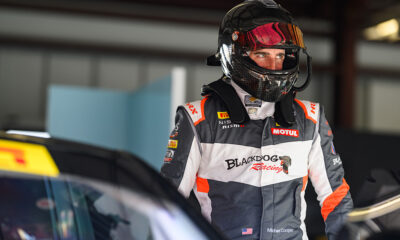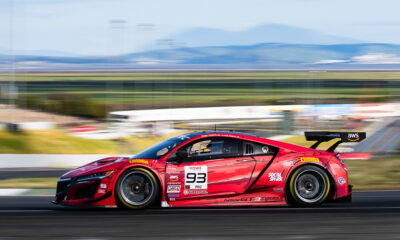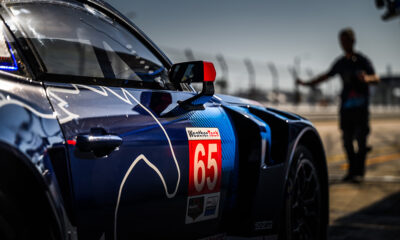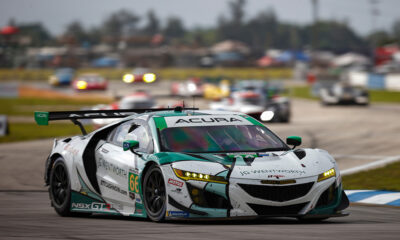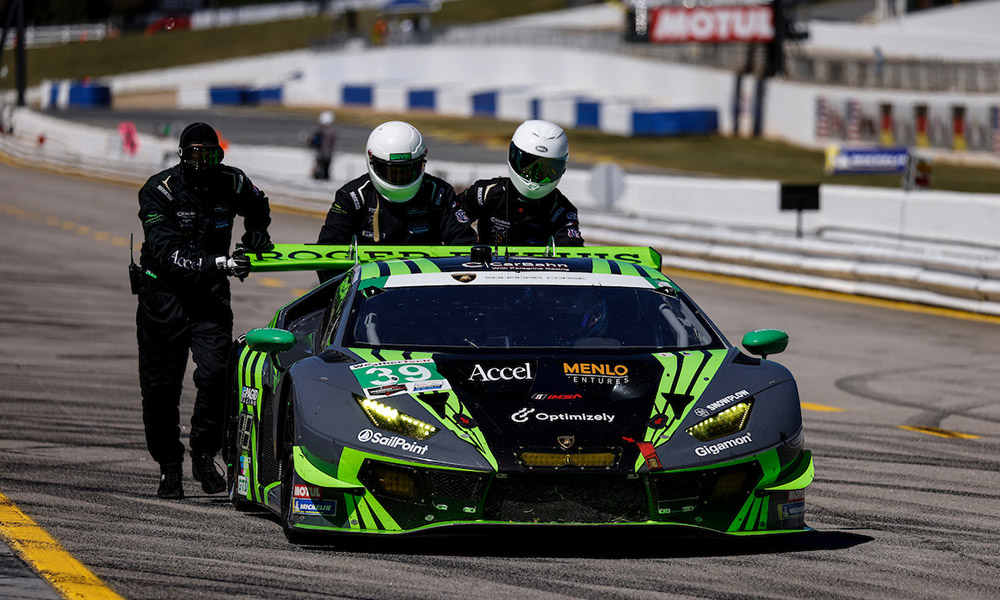
Photo: Mike Levitt/IMSA
Road Atlanta is in my personal top-five favorite circuits. I love the short, fast, flowing nature that it provides. Petit Le Mans is the last race on the IMSA calendar—a ten-hour enduro that truly is one of the busiest races all year.
It’s busy due to the length of circuit (just over 2 miles) with 40-50 cars, five classes and lap time deltas that approach ten seconds or more per lap. As you flow up and over the rolling Georgian foothills, a prototype inevitably appears on your bumper even when you last checked the rear mirror 5-10 seconds ago.
The traffic challenge here is immense. As we race amongst ourselves in GTD and GTD Pro, there is a sort of nip/tuck flow that happens with the DPi, LMP2 and LMP3.
Given that we are in the most widely subscribed category of them all, I can’t help but think about how much more relaxing it could be if we weren’t racing in the windshield and the rear view mirror at the same time.
Nonetheless, every year there is contact between the prototype cars and the GT cars, and it habitually happens in the same two locations.
1. The entry to the esses—a downhill, off camber right hander that’s flat out for us in GT when the car is working perfectly, but a slight breathe just to get the nose down to turn-in otherwise. The entry speed is roughly 115-120 mph, and we are high in 4th gear.
2. The entry to turn 12—the final corner. A massive downhill (and when I say massive, I mean it—you can grenade your golf cart motor due to gravity/speed you can achieve) that feeds into a funnel-style bend to the right with walls encroaching at the apex, making it a narrow corridor. This corner is also flat out, also high in 4th gear and around the same mph for us (120 mph +/-).
In both of these cases, the prototype cars have just started gaining ground from the previous corner, and they often look, optimistically, to use their momentum into the inviting space that funnels ahead.
The reality here is that all drivers know it’s a problem. We speak about it in the drivers’ briefing, and yet cars are still destroyed every single year. It’s sort of the nature of the beast when thinking about Petit Le Mans.
Our Petit was shaping up to be a great one. We had a good race car, a stellar qualifying from Robert Megennis put us P2, and our top notch drivers and team in the pit lane were hungry for redemption after the last Endurance round at Watkins Glen where the No. 39 was invited into a wall at 130 mph.
At the drop of the green, Robert was stuck in a good ol’ fashioned traffic jam. The Risi Ferrari ahead missed the green and didn’t accelerate, meaning our column didn’t go, and the outside column was off to the races. IMSA rules require all cars to stay within their respective columns until the start/finish line before moving to pass, so we were trapped.
We initially lost two to three positions before Turn 1, but Robert fought his way back to third after 20-25 min.
Just as everyone was starting to settle in for the long haul with 9 hours and 25 minutes of racing left, I heard a sudden panic from everyone in pit lane on the radio. If I recall, the exact verbiage was, “Ahh, it’s US!”
Frantically, I scanned the track CCTV channels looking for the infamous black, gray and green machine, only to see it stopped on the right side of the road, just past the pit exit as it merges into Turn 2 at the top of the hill.
The report was that we had no throttle movement in relation to what the pedal was requesting.
This meant, at minimum, it was a flat tow back to pit lane, and at least two to three laps lost in that recovery process alone. But that doesn’t factor in the diagnosis and remedy on the car, which can generally take a long time, especially with an electrical issue.
After about 20-25 mins in the paddock, the team identified that there was a failure in the chassis harness between the pedal box and the ECU, meaning the computer in the car could not see what the throttle pedal was doing.
By now, we were almost 20 laps down from the GTD leaders, and the race had already slipped through our hands. The only decision left was risk/reward on continuing to drive but finishing at the back of the field.
Considering the risk that Petit naturally poses for cars and contact, plus our chances of anything but P-last being pretty much shot, we opted to retire the car and cement the end of our first full season in the IMSA WeatherTech SportsCar Championship.
It was a campaign filled with high highs, and low lows. With such tumultuous luck and emotions, it only feels right to hit the ground running for a stellar 2023 campaign.
2022 left me wanting more. Much more…


















